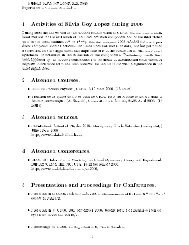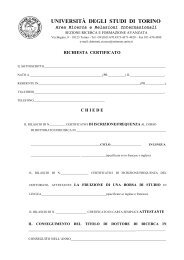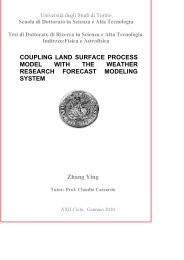Neutron measurements in the LNGS Underground Laboratory
Neutron measurements in the LNGS Underground Laboratory
Neutron measurements in the LNGS Underground Laboratory
- No tags were found...
You also want an ePaper? Increase the reach of your titles
YUMPU automatically turns print PDFs into web optimized ePapers that Google loves.
2° year PhD Sem<strong>in</strong>ar:<strong>Neutron</strong> <strong>measurements</strong> <strong>in</strong> <strong>the</strong><strong>LNGS</strong> <strong>Underground</strong> <strong>Laboratory</strong>Candidate:Dr. Antonio BonardiSupervisor:Prof. Piero GaleottiAssistentant Supervisors:Dr. Walter FulgioneDr. Marco Aglietta15 January 2009 1Antonio Bonardi - 2° year PhD Sem<strong>in</strong>ar - <strong>Neutron</strong> measurement <strong>in</strong> <strong>the</strong><strong>LNGS</strong> <strong>Underground</strong> <strong>Laboratory</strong>
<strong>Neutron</strong> background for undergroundlaboratories experiments<strong>Neutron</strong> background is troublesome for:• Neutr<strong>in</strong>o experiments• Dark Matter experiments• ββ-decay experimentsbecause neutron <strong>in</strong>teraction signal is able to mimic <strong>the</strong> expected signal of all of<strong>the</strong>se k<strong>in</strong>ds of experiment.<strong>Neutron</strong> background comes from:a) Natural radioactivity due to radioactive isotopes decay or to (α,n)reactions on elements that are present <strong>in</strong>side underground laboratory’sfacilities or <strong>in</strong>side <strong>the</strong> experimental apparatus itself.b) Muon hadronic <strong>in</strong>teractions <strong>in</strong> <strong>the</strong> rock or <strong>in</strong> <strong>the</strong> experimental apparatusitself (e.g. a lead γ-rays shield<strong>in</strong>g).Antonio Bonardi - 2° year PhD Sem<strong>in</strong>ar - <strong>Neutron</strong> measurement <strong>in</strong> <strong>the</strong>15 January 2009 2<strong>LNGS</strong> <strong>Underground</strong> <strong>Laboratory</strong>
<strong>Neutron</strong> background for undergroundlaboratories experiments:- Natural radioactivity neutrons• The energy is low: E neutron
<strong>Neutron</strong> background for undergroundlaboratories experiments:- Muon-<strong>in</strong>duced neutrons• Total flux is 2÷3 order of magnitude less thanprevious ones• There are 2 different classes:1. “evaporation neutrons”:‣ produced by photo-nuclear<strong>in</strong>teractions‣ low energy (E neutron
LVD: Large Volume Detector- OverviewLVD is located <strong>in</strong> <strong>the</strong> hall A of INFN NationalLaboratories of Gran Sasso, under about 3500m.w.e.LVD has acquired data s<strong>in</strong>ce 1992 and it hasbeen <strong>in</strong> <strong>the</strong> actual configuration s<strong>in</strong>ce 1999:nowaday <strong>the</strong> active mass is 1 Kton of organicliquid sc<strong>in</strong>tillator (C nH 2n, ρ ~ 0.8 g cm -3 )Antonio Bonardi - 2° year PhD Sem<strong>in</strong>ar - <strong>Neutron</strong> measurement <strong>in</strong> <strong>the</strong>15 January 2009 5<strong>LNGS</strong> <strong>Underground</strong> <strong>Laboratory</strong>
LVD: Large Volume Detector- Overview• The ma<strong>in</strong> goal is to observe and to study neutr<strong>in</strong>o bursts due togravitational collapse of massive objects <strong>in</strong> <strong>the</strong> Milky Way and <strong>the</strong> nearestgalaxies.• LVD takes part of SNEWS (SuperNova Early Warn<strong>in</strong>g System) projecttoge<strong>the</strong>r with ICECUBE, Super-K.• LVD works also as CNGS beam monitorCrab NebulaSN1987AAntonio Bonardi - 2° year PhD Sem<strong>in</strong>ar - <strong>Neutron</strong> measurement <strong>in</strong> <strong>the</strong>15 January 2009 6<strong>LNGS</strong> <strong>Underground</strong> <strong>Laboratory</strong>
LVD: Large Volume Detector- Overview3 totally <strong>in</strong>dependent towers35 (+3 switched off) modules sorted on 5columns and 7 levels8 counters (1.5 m x 1 m x 1 m) filled with 1.2tons of liquid sc<strong>in</strong>tillator3 PMTs (6” photo-cathode) for light’s collectionplaced on <strong>the</strong> top surfaceAntonio Bonardi - 2° year PhD Sem<strong>in</strong>ar - <strong>Neutron</strong> measurement <strong>in</strong> <strong>the</strong>15 January 2009 7<strong>LNGS</strong> <strong>Underground</strong> <strong>Laboratory</strong>
LVD: Large Volume Detector- OverviewActive MassDuty CycleAntonio Bonardi - 2° year PhD Sem<strong>in</strong>ar - <strong>Neutron</strong> measurement <strong>in</strong> <strong>the</strong>15 January 2009 8<strong>LNGS</strong> <strong>Underground</strong> <strong>Laboratory</strong>
LVD: Large Volume Detector- <strong>Neutron</strong>’s measurementn + p 1 n + p 1E vis=E(p 1)+E(p 2)+...+E(p n)ε~50%τ~190 μsΕ γ= 2.2 MeVn + p 2 n + p 2n + p n n + p nn + p d + γIf E vis> E Threshold= 4 MeV (HET)E threshold~ 1 MeV (LET) , Δt = 1msIt’s possible to discrim<strong>in</strong>ate neutrons from o<strong>the</strong>r background sources by look<strong>in</strong>g for protonrecoil signal followed by a neutron capture signal.Antonio Bonardi - 2° year PhD Sem<strong>in</strong>ar - <strong>Neutron</strong> measurement <strong>in</strong> <strong>the</strong>15 January 2009 10<strong>LNGS</strong> <strong>Underground</strong> <strong>Laboratory</strong>
LVD: Large Volume Detector- <strong>Neutron</strong>’s measurementRecoil<strong>in</strong>g protons are strongly non-relativistic!!For E
LVD: Large Volume Detector- <strong>Neutron</strong>’s measurementn + A Gd A+1 Gd + γ sε ~ 70%ε~50%τ~190 μsΕ γ= 2.2 MeVLS + 0.1% Gdτ ~ 25 μsΣΕ γ~ 8 MeVAntonio Bonardi - 2° year PhD Sem<strong>in</strong>ar - <strong>Neutron</strong> measurement <strong>in</strong> <strong>the</strong>15 January 2009 12<strong>LNGS</strong> <strong>Underground</strong> <strong>Laboratory</strong>
<strong>Neutron</strong>’s measurement-GdR&DIn 2005 we have doped with 0.1% Gd a LVD counter (T3131) and ano<strong>the</strong>r one (T40) usedfor test located <strong>in</strong> <strong>the</strong> <strong>LNGS</strong> mount<strong>in</strong>g hall (on-<strong>the</strong>-ground laboratory)It is possible to perform natural decay neutron’s measurement by trigger<strong>in</strong>g for neutroncapture signal and <strong>the</strong>n look<strong>in</strong>g for a previous signal due to proton recoilWe have to use a new electronics <strong>in</strong>stead of LVD standard electronicsS<strong>in</strong>gle tank measurementAntonio Bonardi - 2° year PhD Sem<strong>in</strong>ar - <strong>Neutron</strong> measurement <strong>in</strong> <strong>the</strong>15 January 2009 13<strong>LNGS</strong> <strong>Underground</strong> <strong>Laboratory</strong>
S<strong>in</strong>gle tank measurement:- The veto apparatus constructionA veto apparatus moduleVeto apparatus assembl<strong>in</strong>g phaseAntonio Bonardi - 2° year PhD Sem<strong>in</strong>ar - <strong>Neutron</strong> measurement <strong>in</strong> <strong>the</strong>15 January 2009 14<strong>LNGS</strong> <strong>Underground</strong> <strong>Laboratory</strong>
S<strong>in</strong>gle tank measurement:- OverviewT40 + veto:•On-<strong>the</strong>-ground laboratory•High background•No radioactivity neutrons•Atmospheric neutrons, E n>10 MeV•Trigger , DAQ and Data Analysistechniques improvement•Trigger on proton recoil signalT3131:•<strong>Underground</strong> laboratory•Very low background•Radioactivity neutrons•Trigger on neutron capture or on protonrecoil signal•Data acquisition is still ongo<strong>in</strong>gAntonio Bonardi - 2° year PhD Sem<strong>in</strong>ar - <strong>Neutron</strong> measurement <strong>in</strong> <strong>the</strong>15 January 2009 15<strong>LNGS</strong> <strong>Underground</strong> <strong>Laboratory</strong>
S<strong>in</strong>gle tank measurement:- T40+veto first resultsAtmospheric neutronsNext Step Geant4 MC simulationAntonio Bonardi - 2° year PhD Sem<strong>in</strong>ar - <strong>Neutron</strong> measurement <strong>in</strong> <strong>the</strong>15 January 2009 16<strong>LNGS</strong> <strong>Underground</strong> <strong>Laboratory</strong>
S<strong>in</strong>gle tank measurement:- T40+veto first resultsAtmospheric stopp<strong>in</strong>g μStopped vs. Pass<strong>in</strong>g trough ratio ~3.0%Next Step New data acquisitionAntonio Bonardi - 2° year PhD Sem<strong>in</strong>ar - <strong>Neutron</strong> measurement <strong>in</strong> <strong>the</strong>15 January 2009 17<strong>LNGS</strong> <strong>Underground</strong> <strong>Laboratory</strong>
Muon-<strong>in</strong>duced neutrons <strong>in</strong>side LVDEnergy range: 20 MeV < E neutron< 450 MeVMuons target countersVeto counters<strong>Neutron</strong> detector’s counterNot considered countersThis work had been repeated for vertical muons pass<strong>in</strong>g trough any LVD columnAntonio Bonardi - 2° year PhD Sem<strong>in</strong>ar - <strong>Neutron</strong> measurement <strong>in</strong> <strong>the</strong>15 January 2009 18<strong>LNGS</strong> <strong>Underground</strong> <strong>Laboratory</strong>
Muon-<strong>in</strong>duced neutrons <strong>in</strong>side LVD:- Selection criteriaMuon target volume:1.Δt=250 ns;2.E released≥50 MeV for L=1 && L=7;3.N counters(E released≥50 MeV) ≥ 5;Veto volume:1.Δt=250 ns;2.NO counter E released≥100 MeVAntonio Bonardi - 2° year PhD Sem<strong>in</strong>ar - <strong>Neutron</strong> measurement <strong>in</strong> <strong>the</strong>15 January 2009 19<strong>LNGS</strong> <strong>Underground</strong> <strong>Laboratory</strong>
Muon-<strong>in</strong>duced neutrons <strong>in</strong>side LVD:- Prelim<strong>in</strong>ary results• What is <strong>the</strong> real detection efficiency?• Why <strong>the</strong> knee?• What energy corrections are to be applied?Geant4 MC simulationAntonio Bonardi - 2° year PhD Sem<strong>in</strong>ar - <strong>Neutron</strong> measurement <strong>in</strong> <strong>the</strong>15 January 2009 20<strong>LNGS</strong> <strong>Underground</strong> <strong>Laboratory</strong>
<strong>Neutron</strong> propagation <strong>in</strong>side LVD• LVD has 1 kton of liquid sc<strong>in</strong>tillar good neutron moderator• LVD is a modular experiment• LVD is a good muon detectorIt is possible to obta<strong>in</strong> a very low background facility for Dark Matter experiment<strong>in</strong>side <strong>the</strong> central part of LVD LVD_CF (LVD Core Facility)Antonio Bonardi - 2° year PhD Sem<strong>in</strong>ar - <strong>Neutron</strong> measurement <strong>in</strong> <strong>the</strong>15 January 2009 21<strong>LNGS</strong> <strong>Underground</strong> <strong>Laboratory</strong>
<strong>Neutron</strong> propagation <strong>in</strong>side LVD:- First resultsNatural radioactivity neutron flux attended <strong>in</strong>sideGran Sasso underground Laboratories.H.Wulandari et al “<strong>Neutron</strong> Flux at <strong>the</strong> Gran Sasso<strong>Underground</strong> <strong>Laboratory</strong> Revisited” hepex/0312050Simulated neutrons arriv<strong>in</strong>g at LVD_CFAttenuation factor for E n >1MeV ~ 37Φ(E n>1 MeV) = 5.8 10 -7 cm -2 s -1Φ(E n>1 MeV) = 1.6 10 -8 cm -2 s -1H.Wulandari, et alAntonio Bonardi - 2° year PhD Sem<strong>in</strong>ar - <strong>Neutron</strong> measurement <strong>in</strong> <strong>the</strong>15 January 2009 22<strong>LNGS</strong> <strong>Underground</strong> <strong>Laboratory</strong>
2° year PhD Sem<strong>in</strong>ar:<strong>Neutron</strong> <strong>measurements</strong> <strong>in</strong> <strong>the</strong><strong>LNGS</strong> <strong>Underground</strong> <strong>Laboratory</strong>Antonio Bonardi - 2° year PhD Sem<strong>in</strong>ar - <strong>Neutron</strong> measurement <strong>in</strong> <strong>the</strong>15 January 2009 23<strong>LNGS</strong> <strong>Underground</strong> <strong>Laboratory</strong>









